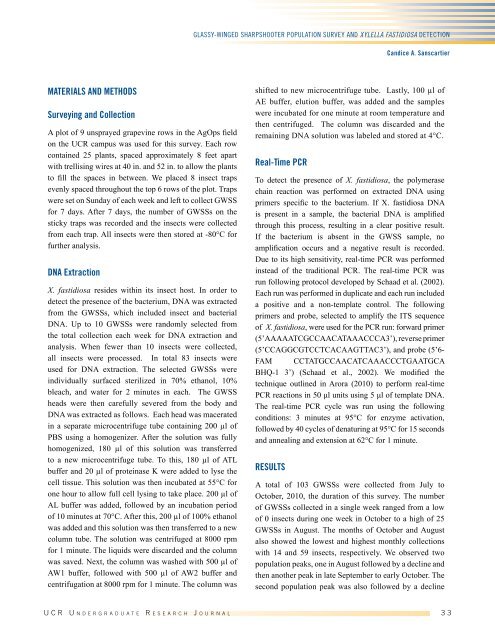Undergraduate Research Journal
Undergraduate Research Journal
Undergraduate Research Journal
Create successful ePaper yourself
Turn your PDF publications into a flip-book with our unique Google optimized e-Paper software.
Glassy-Winged Sharpshooter Population Survey and Xylella fastidiosa Detection<br />
Candice A. Sanscartier<br />
Materials and methods<br />
Surveying and Collection<br />
A plot of 9 unsprayed grapevine rows in the AgOps field<br />
on the UCR campus was used for this survey. Each row<br />
contained 25 plants, spaced approximately 8 feet apart<br />
with trellising wires at 40 in. and 52 in. to allow the plants<br />
to fill the spaces in between. We placed 8 insect traps<br />
evenly spaced throughout the top 6 rows of the plot. Traps<br />
were set on Sunday of each week and left to collect GWSS<br />
for 7 days. After 7 days, the number of GWSSs on the<br />
sticky traps was recorded and the insects were collected<br />
from each trap. All insects were then stored at -80°C for<br />
further analysis.<br />
DNA Extraction<br />
X. fastidiosa resides within its insect host. In order to<br />
detect the presence of the bacterium, DNA was extracted<br />
from the GWSSs, which included insect and bacterial<br />
DNA. Up to 10 GWSSs were randomly selected from<br />
the total collection each week for DNA extraction and<br />
analysis. When fewer than 10 insects were collected,<br />
all insects were processed. In total 83 insects were<br />
used for DNA extraction. The selected GWSSs were<br />
individually surfaced sterilized in 70% ethanol, 10%<br />
bleach, and water for 2 minutes in each. The GWSS<br />
heads were then carefully severed from the body and<br />
DNA was extracted as follows. Each head was macerated<br />
in a separate microcentrifuge tube containing 200 µl of<br />
PBS using a homogenizer. After the solution was fully<br />
homogenized, 180 µl of this solution was transferred<br />
to a new microcentrifuge tube. To this, 180 µl of ATL<br />
buffer and 20 µl of proteinase K were added to lyse the<br />
cell tissue. This solution was then incubated at 55°C for<br />
one hour to allow full cell lysing to take place. 200 µl of<br />
AL buffer was added, followed by an incubation period<br />
of 10 minutes at 70°C. After this, 200 µl of 100% ethanol<br />
was added and this solution was then transferred to a new<br />
column tube. The solution was centrifuged at 8000 rpm<br />
for 1 minute. The liquids were discarded and the column<br />
was saved. Next, the column was washed with 500 µl of<br />
AW1 buffer, followed with 500 µl of AW2 buffer and<br />
centrifugation at 8000 rpm for 1 minute. The column was<br />
shifted to new microcentrifuge tube. Lastly, 100 µl of<br />
AE buffer, elution buffer, was added and the samples<br />
were incubated for one minute at room temperature and<br />
then centrifuged. The column was discarded and the<br />
remaining DNA solution was labeled and stored at 4°C.<br />
Real-Time PCR<br />
To detect the presence of X. fastidiosa, the polymerase<br />
chain reaction was performed on extracted DNA using<br />
primers specific to the bacterium. If X. fastidiosa DNA<br />
is present in a sample, the bacterial DNA is amplified<br />
through this process, resulting in a clear positive result.<br />
If the bacterium is absent in the GWSS sample, no<br />
amplification occurs and a negative result is recorded.<br />
Due to its high sensitivity, real-time PCR was performed<br />
instead of the traditional PCR. The real-time PCR was<br />
run following protocol developed by Schaad et al. (2002).<br />
Each run was performed in duplicate and each run included<br />
a positive and a non-template control. The following<br />
primers and probe, selected to amplify the ITS sequence<br />
of X. fastidiosa, were used for the PCR run: forward primer<br />
(5’AAAAATCGCCAACATAAACCCA3’), reverse primer<br />
(5’CCAGGCGTCCTCACAAGTTAC3’), and probe (5’6-<br />
FAM CCTATGCCAACATCAAACCCTGAATGCA<br />
BHQ-1 3’) (Schaad et al., 2002). We modified the<br />
technique outlined in Arora (2010) to perform real-time<br />
PCR reactions in 50 μl units using 5 μl of template DNA.<br />
The real-time PCR cycle was run using the following<br />
conditions: 3 minutes at 95°C for enzyme activation,<br />
followed by 40 cycles of denaturing at 95°C for 15 seconds<br />
and annealing and extension at 62°C for 1 minute.<br />
RESULTS<br />
A total of 103 GWSSs were collected from July to<br />
October, 2010, the duration of this survey. The number<br />
of GWSSs collected in a single week ranged from a low<br />
of 0 insects during one week in October to a high of 25<br />
GWSSs in August. The months of October and August<br />
also showed the lowest and highest monthly collections<br />
with 14 and 59 insects, respectively. We observed two<br />
population peaks, one in August followed by a decline and<br />
then another peak in late September to early October. The<br />
second population peak was also followed by a decline<br />
U C R U n d e r g r a d u a t e R e s e a r c h J o u r n a l 3 3














